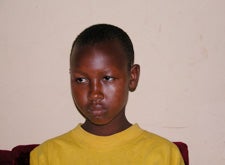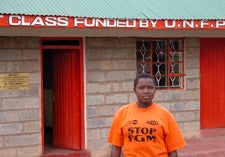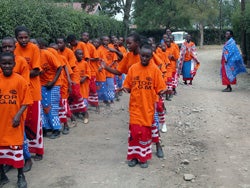News
A Safe Haven for Girls Escaping Harm in Kenya
- 09 September 2005
News
NAROK, Kenya—Silvia Selula looks dazed and lost. A faint wrinkle creases her otherwise cherubic face. Occasionally a furtive smile appears at the corner of her mouth. Her face says a lot about what she has endured, especially in the last few weeks, and about her optimism about the future. Silvia is the latest addition to the Tasaru Ntomonok Girls Rescue Centre in Narok, Kenya.

Most of those who listen to her mumble her story shake their heads and wonder how the fate that almost befell Silvia could be tolerated in Kenya today. Silvia is nine years old. A few weeks ago, her father married her off to a 40-year-old man. She had no say in the arrangement. Neither did her mother, who reluctantly acquiesced. It is, after all, still a man’s world on the rolling plains of the Southern Rift Valley, the home of the Maasai.
All the wedding rites were performed according to Maasai custom, wedding photographs were taken and Silvia was being frog-marched to her husband’s home to become his fourth wife. But luck was on Silvia’s side. Somebody alerted Agnes Pareyio, the indefatigable director of the Tasaru Ntomonok Girls Rescue Centre in Narok. She enlisted the assistance of the local government authorities and freed Silvia. The groom escaped, but Sylvia’s father was tried and jailed for one year.
Stories similar to Silvia’s occur all over Kenya everyday, but many girls aren’t so lucky. In addition to being forced into child marriage, many are subjected to the harmful practice known as female genital mutilation/cutting (FGM/FGC). Recent figures from Kenya’s Demographic and Health Survey indicate that more than 40 per cent of women between the ages of 15 and 19, and over half of women above the age of 35, have been subjected to some form of the practice.
Phyllis Kamwaro, 16, took refuge at the rescue centre three years ago, at the behest of her teacher, after her father, a police officer, tried to get her to undergo FGM/FGC. The District Commissioner and other police officers tried in vain to dissuade him from subjecting his daughter to the ordeal. Her father threatened to kill her and those protecting her. He threatened Phyllis’ mother with death if she dares to visit her daughter. As further punishment, he has refused to pay for the education of her six younger siblings.

For Phyllis, the rescue centre represents not just safety but also hope for a brighter future. “I want to be a doctor,” she says. “The centre is like my family now. We help each other.”
Female genital mutilation/cutting is a deeply rooted tradition, not only in Kenya, but also in Somalia, Tanzania, Uganda and some countries in West Africa and the Arab States. Though it was outlawed in Kenya in 2001, many communities, such as the Pokots and the Maasai, continue to practice FGM/FGC as an important rite of passage to womanhood. Some men insist on marrying only women who have been cut. Others are stigmatized as cowards.
“In this community, girls are circumcised between 9 and 13 years and, soon after, married off. Marrying off young girls is the end of the road for their education. We must not allow this,” says Ms. Pareyio.
UNFPA, United Nations Population Fund, is working with governments and civil society organizations in a global campaign to eliminate gender-based violence, including FGM/FGC and forced marriage. In this way, UNFPA helps countries meet Millennium Development Goal 3: to promote gender equality and empower women.
The Fund’s support is evident in the Tasaru Ntomonok Girls Rescue Centre, which was created in 1999 as part of a project aimed at addressing FGM/FGC and forced marriages.
Tasaru ntomonok means ‘rescue the woman’ in the local Maa language. The Centre caters to girls who have been thrown out of their homes for running away from FGM/FGC or forced marriages. It provides Sylvia and 57 other residents with shelter, protection education and skills training.
UNFPA funded the construction of the building where the girls receive training. It also pays school fees for the girls and supports outreach and advocacy activities. The project leases a 100-hectare farm where the centre grows wheat and runs a maize mill to provide income for women who formerly earned money by performing FGM/FGC. Proceeds from the farm help make the centre more sustainable.
Beyond protecting and offering educational and vocational training opportunities to the girls, the rescue centre also tries to reconcile them with their parents and communities. So far, it has reunited 88 girls with their families.
The second pillar of the Tasaru Ntomonok initiative is an alternative rite of passage to womanhood – without the cut. It is an example of a culturally sensitive approach – one that respects the value of the tradition, but rejects the violence associated with it.
“The law makes female genital mutilation and cutting illegal. But it will take a long time for it to be effective. In the meantime, we need to be educating and sensitizing our communities about the negative effects of the practice. We also need to offer them alternative rites of passage,” says Ms. Pareyio.
The Tasaru Ntomonok initiative conducts two rites of passage yearly, in August and November. Participants, ages nine and older, are voluntarily enrolled in the rite by their parents. The ceremony replaces FGM/FGC, to which participants would otherwise have been subjected.
During the first five days in residence, the girls are given culturally appropriate lessons on reproductive health, sexuality and the challenges of adulthood. “We invite old women to teach the young girls everything in their culture except cutting. They are taught social interaction, including how to handle their home and husband,” says Ms. Pareyio.

On the sixth day, parents and other members of the community are invited to a public ceremony marking the girls’ transition to adulthood. Prayers are offered by the girls’ godmothers. The ceremony is accompanied by communal feasting, certificates and gifts, declarations by the girls that they will not be cut, and promises by the parents and the community leaders to abandon FGM/FGC.
The Tasaru Ntomonok initiative has, so far, offered 350 girls an alternative rite of passage to womanhood. Speaking to last August’s graduates, Fabian Byomuhangi, UNFPA Deputy Representative, advised the 40 girls to have faith in themselves. He warned parents not to construe the rite of passage as an indication that the girls were now ready for marriage. “They must given the chance to continue their education for as long as they desire,” he said.
Improving educational prospects for girls and women is another way in which this project furthers the achievement of the Millennium Development Goals. Reducing disparities in education is one of the targets associated with the goal of empowering women.
Contact Information:
George Ngwa, tel. +27-12 354 8405 (office), + 27-72 617 1032 (cell), ngwa@unfpa.org